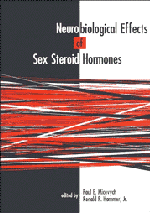Book contents
- Frontmatter
- Contents
- List of contributors
- Dedication
- Preface
- Acknowledgments
- Part I Sex steroid–responsive circuits regulating male and female reproductive behaviors
- 1 Hormonal influence on neurons of the mating behavior pathway in male hamsters
- 2 Neural circuitry for the hormonal control of male sexual behavior
- 3 Estrogen receptor mRNA: neuroanatomical distribution and regulation in three behaviorally relevant physiological models
- 4 Hormonal regulation of limbic and hypothalamic pathways
- Part II Sex steroid interactions with specific neurochemical circuits
- Part III Cellular and molecular mechanisms regulated by sex steroids
- Index
2 - Neural circuitry for the hormonal control of male sexual behavior
Published online by Cambridge University Press: 15 October 2009
- Frontmatter
- Contents
- List of contributors
- Dedication
- Preface
- Acknowledgments
- Part I Sex steroid–responsive circuits regulating male and female reproductive behaviors
- 1 Hormonal influence on neurons of the mating behavior pathway in male hamsters
- 2 Neural circuitry for the hormonal control of male sexual behavior
- 3 Estrogen receptor mRNA: neuroanatomical distribution and regulation in three behaviorally relevant physiological models
- 4 Hormonal regulation of limbic and hypothalamic pathways
- Part II Sex steroid interactions with specific neurochemical circuits
- Part III Cellular and molecular mechanisms regulated by sex steroids
- Index
Summary
Role of the medial preoptic area in the hormonal control of male sexual behavior
Mating behaviors of males provide excellent examples of the neurobiological effects of sex steroid hormones. In mammals (Larsson 1979; Michael and Bonsall 1979; Sachs and Meisel 1988), birds (Balthazart 1983; Silver et al. 1979), and other vertebrates (Crews 1979; Crews and Silver 1985; Kelley and Pfaff 1978), testosterone (T) promotes the sexual activity of adult males. Gonadally intact males are more likely to mount receptive females, and to copulate to ejaculation, than are castrated males, unless the castrates are given T. Although these stimulatory effects of T result largely from its action on the brain (Kelley and Pfaff 1978; Larsson 1979; Sachs and Meisel 1988), T also acts on the penis and spinal neurons to affect copulatory performance (Breedlove 1984; Hart 1978; Hart and Leedy 1985; Sachs 1983).
Within the brain, one of the most important areas mediating the effects of T on male sex behavior is the medial preoptic area (MPOA) or the MPOA–anterior hypothalamus (AH) continuum. The MPOA–AH contains many cells that accumulate T or its metabolites, estradiol (E) and dihydrotestosterone (DHT) (Kelley and Pfaff 1978; Luine and McEwen 1985; Michael and Bonsall 1990). However, the conclusion that the MPOA–AH mediates many of the effects of T on male sexual behavior is based on the behavioral changes produced by manipulations of this area (Sachs and Meisel, 1988). Implanting T or E into the MPOA–AH restores mounting in castrated males, and lesioning the MPOA–AH eliminates sexual behavior in males that are exposed to circulating T.
- Type
- Chapter
- Information
- Neurobiological Effects of Sex Steroid Hormones , pp. 40 - 56Publisher: Cambridge University PressPrint publication year: 1995
- 6
- Cited by



